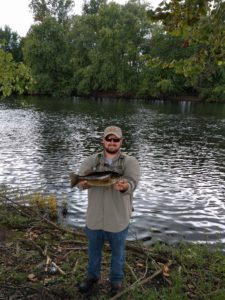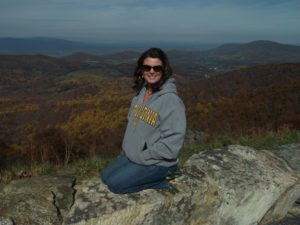Just a few years ago, Berkeley County had literally no stormwater program. Today, they’re improving water quality across the county, receiving grants to prevent flooding and protect watersheds, and partnering with local organizations to educate and engage the community. All because of one stormwater manager with a vision — and the conviction that there must be a better way.
Stormwater Program with Momentum

Today, Zack Walburn, MS4 Coordinator for Berkeley County, WV, feels confident that the county’s stormwater program is moving well in the right direction, toward better stormwater management and cleaner water. He and his small team have recently brought in over $1.59 million in grant funding to address water quality and flooding along key roads and watersheds and to convert legacy stormwater assets to green infrastructure. They’ve organized partnerships across the region, creating internships, running trash cleanups, and educating students from elementary school to college about the importance and impact of stormwater.
Zack is a great believer in partnerships. He’s gotten to know his state regulators so they can work together toward cleaner, better managed stormwater, an important goal for Berkeley County. Berkeley County is outlined on one edge by the Potomac River, and more than 15 impaired waterways on the EPA 303(d) list run through the county. The MS4 for Berkeley County excludes Martinsburg, the largest city and county seat, and the county is otherwise largely rural, but growing fast.
All this success and momentum, however, is brand new. Just a few short years ago Berkeley County had literally no stormwater program: no staff, no maps of stormwater facilities or structural stormwater assets, just a languishing permit and increasingly urgent scrutiny from the EPA.
“With limited resources, funding, and personnel, we had to find a better way.”
— Zack Walburn, MS4 Coordinator for Berkeley County, WV
What accounts for this rapid turnaround? A small fee, a stormwater manager with a passion for clean water, and 2NFORM — powerful software with the best stormwater science at its core.
Starting From Zero
Before 2019, Berkeley County suffered from a common problem: a lack of funding for stormwater management. To fix this, the county adopted a water quality service fee, a new $3.50 monthly fee on all developed real estate in the MS4. Zack calls this fee an “historic victory,” because it made the stormwater program possible. With funding in place, the county hired Zack and tasked him with developing a stormwater program for Berkeley County, essentially from scratch. To help him do so, the county also hired a team of two MS4 Inspectors and a Stormwater Administrative Assistant. But even with a program and staff in place, the challenges Zack faced were substantial.
“We really had no attributes, features, or locations” of structural stormwater assets, Zack says. The team truly were starting from zero: there was literally no stormwater program in Berkeley County prior to 2019. There were no maps of stormwater facilities. Structural stormwater assets were scattered across the county, but no one knew what type they were, where they were, or what condition they were in. Even figuring out where to begin was difficult — Zack knew that solving problems piecemeal wouldn’t achieve his goals: he needed a systems-based approach that worked for the entire hydrologic landscape.
There Has To Be a Better Way
The need for stormwater management was also growing, along with the county. The population of Berkeley County exploded in recent years due to its proximity to the Washington D.C. metro area. One big effect of this growth: new construction projects have increased dramatically. While in 2017 and 2018 only 150-200 construction inspections were completed each year, in 2019 the team did over 750 construction inspections. They currently expect to do about 700-900 every year.

Kristi Woodward, the Stormwater Administrative Assistant, remembers the “old school” method of construction inspections. Making field notes with paper and pencil, taking photos on phones, then coming back to the office. Digitizing the material took further steps: dropping photos into a word doc, adding the notes, scanning and attaching docs together. It was a lot of work, and very time consuming.
Zack knew he couldn’t build the kind of forward-looking, effective stormwater program he wanted using techniques like this. “With limited resources, funding, and personnel, we had to find a better way,” Zack says. “We have to be lean and mean and nimble” to meet the challenge. He turned to technology to find a way forward.
“2NFORM fills the role of three to four additional people for us.”
— Zach Walburn, MS4 Coordinator for Berkeley County, WV
Zack tested out several different software solutions, and found that “2NFORM blew everybody else out of the water. It checked all our boxes.”
The robust software provides intelligent stormwater management and compliance. Foundational modules handle information management and reporting on the six minimum control measures required by most MS4 permits. Additional modules empower stormwater managers with advanced analytics and planning capabilities, using the data collected for compliance to drive actual improvements in water quality.
Zack persuaded the District’s board members to invest in 2NFORM. Now the real work could begin.
Learn how Elsmere, DE is using 2NFORM to help manage their small town’s stormwater
Read the case studyTo Compliance — and Beyond
Over the past few years, Zack has had “a lot of good conversations” with his state regulators. “I want to open up and be really transparent with our regulators,” he says. “Give them a peek into our program and show them we’re striving for compliance.”
The result of his candor is an individualized MS4 permit for Berkeley County, customized to their circumstances. This way, everyone agrees on what steps the county needs to take in order to achieve real results: less polluted waterways, less flooding, better managed watersheds. Handled this way, MS4 compliance becomes a tool to achieve clean water goals.
“A lot of MS4 compliance is subjective,” Zack says. “2NFORM gives us an objective way to see how we’re doing and show our regulators our real numbers. We can show them that we’re moving toward compliance. I would say that 2NFORM saved us two years of development in getting our program to where it is now, and it will continue to save us time as we do more with the software.”
Building the Backbone of a Stormwater Program
“I struggled with starting a majority of the program from scratch,” Zack says. “2NFORM gives us a standard operating procedure and a framework for organizing our efforts. Having this backbone of the program is really key. I can jump into a specific module, go through the procedures, get the inspection done, and it’s all tracked.”
The first step, Zack and regulators agree, is to map all of the structural stormwater assets in the county. The next step will be to assess the assets and evaluate water quality standards through outfall monitoring. 2NFORM helps with all of these tasks, and more. Zack can visualize features on interactive maps using 2NFORM and ArcGIS. Then he can choose exactly what he wants to share with regulators, and make sure the growing maps of their structural assets are read-only for people outside the team using ArcGIS Online.
“2NFORM saved us two years of development in getting our program to where it is now, and it will continue to save us time as we do more with the software.”
— Zach Walburn, MS4 Coordinator for Berkeley County, WV
Field Inspector David Billmyer heads up the majority of field operations, and he’s the one hunting down structural stormwater assets from the past 30-40 years. David documents these assets using 2NFORM’s built-in methodology. Easy to use forms, to-do lists, and short drop-down menus ensure that he collects all the data points he needs. “Using the software for inspections is great,” David says. “The new form is perfect. Drop down menus make it easier to keep track of what you’ve done, and you can go back to anything you think you may have missed. You can add a photo right there and update the description of the location or issue.”
David also develops a significant amount of the District’s digital content and monthly newsletters. He is a jack of all trades when it comes to the District’s MS4 program, and 2NFORM allows him to seamlessly transition from working on each of the required minimum control measures to his other daily duties.
“Already, 2NFORM has helped us increase our compliance exponentially,” Zack says. “It’s a central hub for us to put everything from our program into, and we use the data analytics to see how we’re doing. We can look at past data, see back in time if we need to, or use the modeling capabilities to set goals for ourselves. We can make our program better by using 2NFORM’s predictive analytics, looking forward three or four years and making data-driven plans to help us achieve our goals.”
Over $1.59 Million in Grants, So Far
“2NFORM has given us the tools to show compliance and provide an actual service to our community,” Zack says. He’s got his eye on the big picture. He and his team aren’t sitting back while they get the foundations of the program up and running: they’re working hard to apply for grants and build partnerships that set them up for even more success.
So far, they’ve brought in over $1.59 million in grant funding. Much of this will go toward different projects that address water quality and flooding issues along a few key roads and watersheds throughout the MS4 service area. Other funds have let them start a stormwater retrofit campaign, converting legacy stormwater assets to green infrastructure within the Chesapeake Bay Watershed. They’ve identified over 15 potential retrofit sites, and used the momentum from one grant to get another, larger grant from the National Fish and Wildlife Foundation.
The green infrastructure workforce development program is funded by a major grant from the National Fish and Wildlife Foundation (NFWF) through its Innovative Nutrient and Sediment Reduction (INSR) program designed to improve water quality in the Chesapeake Bay. The restoration projects planned over the next three years in Berkeley County will remove several tons of sediment and pollution from Opequon Creek and its tributaries, and help West Virginia meet its pollution reduction goals for the Chesapeake Bay watershed. This is the first INSR grant to be awarded in the state of West Virginia.
Where does this small team find the time to apply for grants and build partnerships? The time and effort they save by using 2NFORM to organize and manage their minimum requirements is substantial. The software makes stormwater staff more productive, and more able to make meaningful change. “2NFORM fills the role of three to four additional people for us,” Zack says. “The information is centralized and it keeps us organized. We don’t worry about where to put a file: it’s all in one spot and we know how to access it.”
The Power of Predictive Analytics
“In most of these grant applications, we quantify and model water quality results, based on the predictive analytics in 2NFORM,” Zack says. The built-in analytics are based on environmental science that gives the software unique capabilities to help users plan for the future. The scientists at 2NDNATURE are constantly performing research and publishing peer-reviewed papers that push forward stormwater program efficacy.
“We can make our program better by using 2NFORM’s predictive analytics, looking forward three or four years and making data-driven plans to help us achieve our goals.”
— Zach Walburn, MS4 Coordinator for Berkeley County, WV
Analyses of the data show not only which structural assets are likely to need maintenance next, but where, and how much, trash will accumulate in a community. They show the relationship between outfalls and local waterways so that stormwater managers can do data-driven planning to achieve clean water goals. Historic data stored in the system clearly shows year-over-year improvements. Additionally, 2NFORM puts the data into easy-to-understand maps, paragraphs, and dashboards — great for both annual reports and grant applications.
Community Education, Community Engagement
Partnerships with organizations across the region not only help fulfill the Public Education & Outreach element of Berkeley County’s MS4 permit — they’re also providing real benefits to the stormwater program. A partnership with a local community college, a non-profit watershed group, an environmental consulting firm, and a regional planning office will train the region’s first and only “green collar workforce” by providing internships and hands-on field experience to students over the next three years.
The interns are helping David Billmyer with his efforts to find and map all of the structural stormwater assets in the county, using 2NFORM’s rapid assessment protocol. Interns are also performing trash assessments for priority land use evaluations. They are learning the local roadways and being trained to assess the trash situation along them, so that the stormwater team can propose trash solutions to the County Council and District Board.
In addition, the stormwater team has partnered with the Berkeley County Solid Waste Authority and with the Potomac Valley Audubon Society for public education and outreach. In local schools, third graders now have a tree education curriculum and fourth graders have a watershed education curriculum. These students will grow up with an understanding of the role trees and watersheds play in their local ecology.
Big Plans for a Better Future
Zack is justifiably proud of the work he, David, and Kristi have accomplished, but he’s still looking toward the future. He hopes that the upcoming years will be just as productive, and bring him even closer to the kind of stormwater program he envisions, with more green infrastructure, protected watersheds, and waterways that come off the impaired list. He’s building a sustainable program that will increase climate resilience in Berkeley County, and he’s finding still more partners to work with, to educate the community and give them opportunities to learn and to join the work.
Zack is driven to create a better world with cleaner water, and 2NFORM is here to help him along every step of that path.


